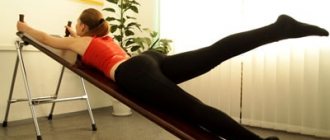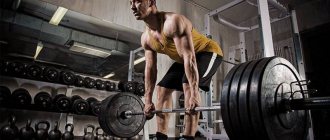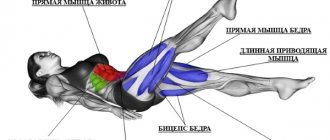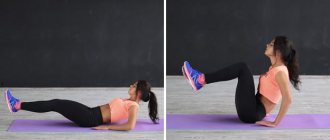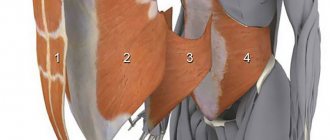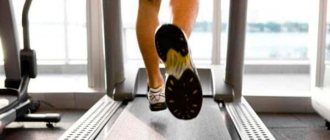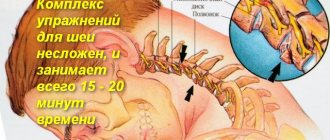© LIGHTFIELD STUDIOS — stock.adobe.com
Share:
An umbilical hernia is a tumor-like elastic protrusion that occurs due to a weakening of the connective tissue framework of the peritoneum. Is it possible to do a plank with an umbilical hernia? How to do your favorite exercise without harm to your health? You will get the answers in our new article.
Plank for vertebral hernia: main nuances
If you have such a disease, a person should not engage in various physical exercises on his own in the first days.
In such a situation, you first need to go to the clinic for a detailed examination and obtain a specific medical opinion. Today, doctors more often allow a patient with a vertebral hernia to do a plank. After all, such an exercise restores tone and strengthens the entire muscular corset of the back.
The “plank” exercise for a herniated lumbar spine is one of the treatment methods that doctors advise doing every day. If you perform the plank correctly, the result will not be long in coming; you will feel the effect within a few weeks.
The back muscles will become stronger, the pain will go away, and your health will improve. But if you do it incorrectly, there is a high probability of harming your body and aggravating the situation with an intervertebral hernia.
- strengthens the muscle corset;
- normalizes blood circulation;
- unloads the spine;
- stabilizes metabolic processes;
- stimulates the nutrition of the spine;
- reduces pain levels;
- promotes muscle relaxation;
- eliminates spasms.
If therapeutic exercises are started in the early stages of the disease, complications, growth of the lesion, and the need for surgery can be prevented. Only the attending physician should choose a set of exercises for lumbar hernia. Self-medication of the disease can lead to harm to the body and accelerate the progression of the disease.
Tips for beginners
The doctor decides whether it is possible to do a plank for a herniated spine. An independently drawn up training plan can lead to aggravation of the disease and complications. Usually static exercises are allowed, but it all depends on the stage of the disease.
In case of a vertebral hernia, stands on a movable base (the legs are placed on a platform or gymnastic ball) are not recommended, since there is a high probability of injury.
Patients with a hernia in the lumbar spine should be wary of coolness and drafts. Therefore, before proceeding with the plank, it is necessary to ventilate the room in advance and close the windows tightly.
With a lumbar hernia, careless movements can provoke displacement of the vertebral segments.
The plank strengthens the muscle corset, activates blood flow and metabolism in the nerve fibers and tissues of the spinal column. This is exactly the load that does not require any special movements, and the result will be in just a week of training.
Description of the pathology
Herniation is considered a common defective disease of the vertebral discs. Such a hernial protrusion appears due to the fact that the patient leads a sedentary lifestyle. More often, this disease occurs in office workers.
Before the formation of a hernia, the patient's muscle corset, which holds the spine, is greatly weakened. Thus, in order to avoid the occurrence of such a disease, the patient must expose his body to various physical activities.
In such a situation, it will be enough to perform simple exercises that keep the back muscles in good shape.
But one of the ways to deal with a hernia that has already occurred is to undergo physical therapy. Thus, the patient performs a variety of special exercises, the most modern and effective of which is the plank.
Below we talk in detail about how to properly undergo Plank exercise therapy, and whether it can be done with certain spinal ailments.
What could be the prognosis?
When a patient has a spinal hernia, in the process of performing exercises, it will be possible to cope with various pathological conditions. The plank allows you to strengthen the muscle tissue on the back, ensuring the normal functioning of the intervertebral discs. Such exercises can be performed only after the recommendation of a specialist.
When the patient lifts, the following actions are performed:
- The arms straighten.
- They move apart.
- There is a strong load on the deltoid muscles.
- The arms are straightened and brought into a suspended state.
- Body rotations are performed.
Is it possible to do a plank for a herniated cervical spine?
A hernia of the lumbar and cervical spine does not occur out of the blue. As a rule, this is the result of a negative impact on the spine. But the manifestation of the disease occurs after it is affected by the “provocateur”. Most often, such a “provocateur” can be lifting weights or stretching a muscle corset.
The cause of herniation of the cervical and lumbar spine (L5-S1) is degenerative processes that constantly occur in the intervertebral discs. The etiology of such processes can be very different:
- uneven load on the cervical and lumbar regions. And it's not just lifting weights incorrectly. The cause of the formation of a hernia in the lumbar and cervical regions can also be curvature of the spine, rheumatic diseases, etc.;
- lack of fluid in the body. This negatively affects all connective tissues and discs of the cervical and lumbar spine. The functioning of the discs can only be ensured if the tissues have the required amount of water;
- insufficient physical activity. As a rule, the main treatment for cervical and lumbar hernia is physical activity. But physical activity is also needed in everyday life, because through gymnastics you can develop ligaments and a muscle corset. In addition, physical exercise helps improve blood circulation;
- eating disorder. The human body constantly needs micro and macroelements, as well as proteins, fats and carbohydrates, which enter the body with food. If the amount of these elements in the body decreases, then the bones become porous and weak. As a result, the intervertebral discs of the lower back and neck are destroyed.
If during the examination the doctor discovered a hernia of the lumbar or cervical spine, then he will definitely prescribe exercises for the hernia of the spine. Gymnastics for hernia of the lumbar spine and neck normalizes and strengthens the muscle corset.
It should be remembered that all stress on the abs, legs, and arms must be done very carefully, otherwise a sprain may be added to the hernia.
In addition, experts recommend doing these exercises in water. Because gymnastics in water reduces the load on damaged areas of the cervical spine and lower back. In addition, all exercises are designed to warm up the muscles and improve blood circulation. The basis of any complex is exercises for the press, flexion-extension of the back.
Only a doctor can choose gymnastics in water and on land, for the abs, arms, legs and back, who takes into account all the personal characteristics of the patient, especially the disease of the neck and lumbar region. As a result, the patient receives a completely acceptable recovery program after a hernia of the cervical and lumbar spine.
It is recommended to perform therapeutic exercises, both in water and on the surface, under the supervision of specialists. Most patients who have undergone this type of treatment find that it is best to do the exercises in a group or one-on-one with a therapist. But if this is not possible, then exercises for the abs, for the neck and lumbar region, and exercises in water should be agreed upon with a specialist. And only in this case can they be done independently at home.
Is it possible to do a plank if you have a herniated lumbar spine? Many people who play sports ask this question.
A disorder of the human spine, such as a herniated disc, is a serious problem that places restrictions on a certain type of physical activity.
The attending physician will always tell you what the technology for performing this exercise (plank) should be, and whether there are any advantages to performing it for the human body.
Hernia is one of the most common defective changes in the spine. Appears due to the lack of sufficient and systematic load on the back muscles of most office workers.
To improve your health, you need to perform simple complex exercises, the most effective of which is considered the plank.
However, you need to know how to do it correctly, and whether it will be useful for specific problems with the spine.
For various problems with the spine, static exercises are most beneficial for the patient. Various types of planks will be a good help in strengthening the muscles that support the normal functioning of the spine, provided that they are recommended by the supervising physician.
(Total 1,109, today 1)
- What is an omphalocele?
- Gastroschisis - what is it?
- How to treat intervertebral hernia without surgery
- Methods and technologies for removing intervertebral hernia
- How to treat a lumbar spinal hernia
Should I avoid physical activity if I have spinal problems?
Many have heard similar recommendations from doctors. With osteochondrosis, experts often prohibit: bending over, lifting weights over 3-4 kg, carrying heavy bags, not doing physical exercise, not going to the gym, girls are not allowed to walk in heels, or use a bicycle.
Let's look at each recommendation in order:
- Stop bending over . This is difficult to do if you sit on the bed all the time. During the day, a person bends over many times in everyday life.
- Do not carry objects heavier than 3-4 kg. In a standing or lying position, the spine with all muscle tissues bears the entire weight of the body. This weight exceeds 3-4 kg. In everyday life, people carry many different objects.
- Carry heavy backpacks on your back . It all depends on what weight should be in the body.
- Avoid fitness classes. Weakness and passivity have a negative impact on health.
- Ride a bike . This negatively affects the axial load on the spine, but does not mean at all that it is time to get rid of the bicycle forever. After strengthening the body, this type of physical activity has a very good effect on the patient’s condition.
All these recommendations imply the need to use orthopedic shoes, constantly take a lying position, not physically strain, and not hold bags in your hands, so as not to load the spine and cause aggravation. I personally don’t see this as a normal way out of the current situation.
You need to follow these doctor's recommendations. Consistently and harmlessly strengthen your own body. Adapt him to a normal existence. Restore strength and endurance. Correctly bend over and move your body. The balance of muscle tissue must be restored. The patient must be provided with support and protection.
If you follow these rules, you can do what you love every day without restrictions.
Plank for spinal hernia - reality or myth?
Plank for hernia - reality or myth? Today we will talk about how realistic it is to perform such an exercise as a plank for a herniated spine and what is its peculiarity for the mentioned disease.
Unfortunately, spinal hernia is a fairly common disease. It can even be considered a feature of modern people who spend a lot of time at the computer and do not pay attention to physical activity. After all, it is the sitting position that puts the greatest load on the entire lumbar region.
A hernia occurs when tears form in the intervertebral disc. As a result of such damage, a kind of extrusion of the nucleus pulposus occurs outward.
This leads to various negative consequences - in addition to ordinary discomfort, even acute pain can be felt. In some situations, when the disease is already advanced, serious disturbances in the functioning of internal organs or even the musculoskeletal system as a whole are observed.
What types of planks are contraindicated?
A special type of plank is contraindicated in case of a hernia - when the legs are placed on unstable devices, for example a fitness ball, etc. This is explained by the high likelihood of additional injury and problems with the functioning of the spine.
Before organizing classes, you should check with your doctor to see if there are any contraindications to their implementation. The main contraindications are:
- pregnancy and lactation;
- cardiac dysfunction;
- problems in the functioning of the cardiovascular system;
- infections - you need to cure the disease, normalize the temperature, and only then start exercising.
Supporting the legs on objects is contraindicated in case of a hernia.
Planking for a hernia is usually carried out in 3–4 approaches. This is an effective exercise that helps smooth out pathological curvatures of the back. But overload is very harmful, which is why it is so important to do the plank according to the instructions, following the technique and only gradually increasing the load time.
The plank helps to engage all muscle groups in the process. With regular use, the strength in the affected area increases noticeably. If you work on your body and know its features, doing the exercise will help you feel a surge of strength at any age.
Benefits of regularly performing planks for lumbar hernia
In order to quickly restore your body and recover, the patient must follow a specific technique for performing both of the above exercises. In addition, a person must prepare his body in advance for performing exercise therapy.
Classic plank
The classic plank is very simple.
While performing the classic plank, the patient performs the following actions:
- lies on the floor, on the stomach, presses the feet together, and then places the toes of the feet on the floor. Then, the patient bends his elbows so that his forearms touch the floor and his hands are under his shoulders;
- leans on his palms, toes and forearms, and then slowly raises his body. This way the body weight is distributed evenly;
- keeps the neck and head in line with the unhealthy spinal column. Moreover, the person holds his head in a motionless position;
- pulls in your abdominal muscles and keeps your abs tense. You need to stay in this position for a few seconds;
- strains the muscles of the buttocks and thighs. Such muscles are attracted to each other;
- does not pull the shoulders towards the head;
- fixes his pose, and then imagines his body in the form of an arrow.
Side plank
When performing a side plank, a person performs the following actions:
- lies on the floor - lies on its side. Next, the patient bends the arm on which he rests on the floor (the supporting arm) at the elbow so that the hand is in the chest area;
- slowly raises the body and rests on the forearm of the stubborn left or right hand and the edge of the foot. You can also lean on your legs when they are bent at the knees. Then the patient places the 2nd leg on the edge of the foot in front of the persistent left or right leg;
- fixes his free hand at the waist or extends it along his body;
- fixes his position so that the body does not fall back, and the pelvis stretches upward and does not sag;
- slowly lowers himself and repeats these actions on the 2nd side.
You cannot perform the special “Plank” exercise if you have the following contraindications:
- with internal various bleedings;
- for various heart ailments;
- after suffering a heart attack or stroke;
- in the presence of severe unpleasant ailments;
- during exacerbation of severe infectious diseases;
- with exacerbation of hernias;
- after recently undergoing operations in the area of the spinal vertebrae, training for a herniated disc.
If you want to correctly perform an exercise such as the “Plank” and not harm your own body, then you must first lie on your stomach and straighten your legs as much as possible. Please note that your feet should touch each other and your toes should touch the floor. In this case, your forearms should be on the floor, and your arms should be bent at the elbows. After this, we carry out the “Planck” exercise according to the following algorithm:
- First, you need to slightly lift the body to the upper position using muscle effort. In this case, the entire weight of your body should be evenly distributed on both your feet and forearms. Make sure your forearms are as close to the floor as possible. Bring your legs together quite tightly and rest your feet on the surface of the mat on which you are located. Your head should be clearly at the level of your body, without needing to lower it down or, conversely, lift it up.
- As soon as you take this position, you should pull in your own abs, pressing them as close as possible to the spine. You should hold the muscles in this position for several minutes.
- When performing this action, you should tighten your thigh and gluteal muscles as much as possible.
- When doing the plank, draw a string in your imagination to make it easier for you to get into the correct body position.
The exercise will be most effective when with each approach you increase the time you spend in the plank by literally a couple of seconds. After 2-3 months, performing this load, you will be able to stand in this position for 2-3 minutes without much strain on the body.
This gymnastic exercise is very useful for diseases of the lumbar spine, but you need to be careful when performing the plank. For intervertebral hernia, the exercise has its own characteristics:
- To perform the task, the body is stretched as much as possible while lying on the stomach.
- Lie down so that nothing causes discomfort.
- Place your palms at shoulder level.
- They rise up, leaning on their palms and feet.
- Stay in this position for 25-30 seconds.
- Lower to the starting position and rest.
The plank for a lumbar hernia is performed in 3-4 approaches. This is a good position because it allows you to smooth out lordoses (curves) in your back. Be careful, because overload is harmful to the human body as a whole. Do the exercise correctly and increase the load gradually. During the plank, various muscles are involved.
Don’t forget, if you do gymnastics regularly, muscle strength in the affected area will increase significantly. If you work on your body and take into account its characteristics, then the bar will help you feel great at any age. The strength of this task lies in its regular repetition, taking into account your own well-being. Don't forget to take care of your own health.
The pathology causes discomfort and pain. The disease can cause disruptions in the functioning of the musculoskeletal system, various organs and systems.
The main root cause of the disease is muscle weakness. Therefore, systematic training and well-chosen exercise therapy will become an effective prevention of pathology.
The plank exercise for a herniated spine is a panacea for physical inactivity. It takes a few minutes and uses as many muscles as possible. The main advantage of this stationary pose is that it does not require excessive loads.
With systematic training, the muscle corset in the problem area will be strengthened. To maintain stillness in a stance, the muscles of the back, abs, shoulder girdle, hips and buttocks are involved. In this case, the effect on the lower back will be gentle and careful. Herniated intervertebral discs are not afraid of such a load.
Another advantage of the plank is that the exercise does not require specific conditions and equipment; a gymnastic mat is enough.
To get the maximum benefit from the stance without harming the body, you need to follow the execution technique. Starting position: lying face down on the floor. Legs are straight, feet touching each other, toes pointing to the floor. The upper limbs are bent, elbows and palms lie on the surface.
First, you should lift your body up, distributing the weight on your feet and forearms. The body must be stretched like a string, the muscles of the thighs and buttocks must be strained as much as possible. Deflections in the lumbar area should not be allowed. The head should be an extension of the body, not rise or bend towards the floor. Emphasis can be placed on both the hands and the elbows.
As soon as the position is fixed, you need to retract the abdominal muscles, pulling them towards the spinal column. The position must be held for 10 seconds to 5 minutes.
Trainers advise combining the classic variation with a side plank. Execution sequence:
- Lie on your side, bending your lower arm so that your palm is at chest level;
- Slowly raise your body above the floor using your forearm and the edge of your foot. It is allowed to distribute the weight on both legs, placing the second foot on the edge in front of the supporting leg;
- Extend the unoccupied arm along the body;
- Maintain the position without falling onto your back or sagging;
- Lower yourself smoothly and perform on the other side.
At first, you don’t need to be overly zealous and stand in a position until exhaustion. Each time the duration of the plank position should be increased by 2-3 seconds. Gradually increasing the load, after a couple of months you will be able to hold the bar for 3-5 minutes without much strain.
Today, lumbar hernia is a fairly common disease. As a rule, it occurs due to decreased physical activity and increased stress on the back. Most often, the disease is diagnosed in people who spend a long time sitting: in this position, the maximum load is placed on the lumbar region.
A hernia is a rupture of an intervertebral disc, which leads to protrusion of the nucleus pulposus. As a result, a person feels discomfort, pain, and in the most advanced cases, disturbances in the functioning of the musculoskeletal system and internal organs occur.
One of the reasons for the appearance of a hernia is a weakening of the muscle corset. Accordingly, one of the methods of preventing the disease is constant physical activity and regular training. In addition, exercise therapy is one of the methods for treating intervertebral hernia.
It is important to understand: under no circumstances should you start performing any exercises on your own if an intervertebral hernia has been diagnosed.
First of all, you need to consult a professional. The plank exercise for a lumbar hernia is not contraindicated, however, much depends on the stage of the disease.
Attention!
Since this exercise is excellent for strengthening the muscle corset, it is most often allowed to be performed.
But you need to understand: if a person is not used to physical activity, then it is tedious to prepare the body. Therefore, it is recommended to start doing the plank in several short approaches. For example, stand for 20-30 seconds, then a short break, and then another one or two sets. Gradually, the duration of execution can be increased.
Execution Rules
The plank exercise for a herniated spine is performed as follows.
- you need to lie on your stomach;
- place your palms on the floor at shoulder level;
- raise the body, resting only on the palms and tips of the toes;
- hold your body perfectly straight for 30 seconds.
After this, you can lower yourself, and after a few minutes do another approach.
It is important to note: you should not immediately try to stand in the plank for 2-3 minutes. It is better to gradually increase the duration of the exercise.
In addition, during the exercise, the body muscles should be as tense as possible. You should not allow the lower back to bend: this can only harm the spine. If pain occurs, the exercise should be stopped immediately.
Classic plank
1 Take a position on the floor: lie on your stomach, press your feet together and place your toes on the floor, bend your elbows so that your forearms are on the floor and your hands are under your shoulders. 2 Using muscle effort, leaning on your palms, forearms and toes, evenly lift your body. 3 Keep your neck and head in line with your spine, without raising or lowering your face. 4 Pull in your stomach and keep your abdominal muscles in a static position. 5 Keep the muscles of the buttocks and thighs tense. 6 Do not pull your shoulders towards your head. 7 Fix the position and mentally imagine your body as a string or arrow.
Do applicators help with spinal hernia? Read here.
Forecast
If a person has a spinal hernia, then while performing exercise therapy “plank” he can get rid of various ailments.
A competent and qualified approach to performing such therapeutic exercises accelerates the patient’s recovery after strengthening the back muscle corset. The main thing in this matter is not to rush anywhere and monitor the smoothness of movements, as well as follow all the recommendations of the attending physiotherapist.
If you find an error, please highlight a piece of text and press Ctrl Enter. We will definitely fix it, and you will suffer karma
Execution technique
Exercise therapy for spinal hernia is performed only by those patients who have already developed a hernial protrusion or are at risk.
Thus, the patient does the plank if the following indications are present:
- if there are regular or periodic unpleasant ailments of the lower back;
- with vertebral osteochondrosis;
- if insomnia appears;
- with sedentary work and a sedentary lifestyle;
- if there is a hereditary predisposition to the occurrence of hernial protrusion;
- after the operation;
- with a decrease in motor physical activity.
Doctors often prescribe exercise therapy for spinal hernia to patients after back surgery.
During correct performance of therapeutic exercises, a person quickly restores his body after surgery and prevents the formation of various complications.
When performing exercise therapy “Planck” correctly, the patient follows a specific execution technique. First, he lies on his stomach and straightens his legs. In this situation, the patient's feet are close to each other, and the toes are on the floor.
Also, the patient’s forearms touch the floor, and the right and left arms are bent 90 degrees or more at the elbows.
Then, during the implementation of “Planck” exercise therapy in the presence of a vertebral hernia, a person performs the following actions:
- strains the shoulder, back, pelvic, thigh and other muscles. Thus, during regular exercise, the muscles in the sore area are perfectly strengthened.
- When performing “Planck” exercise therapy for a hernia, the patient does not use any special devices. During such exercise therapy, he uses only a special mat or an ordinary blanket.
- When performing exercise therapy "Planck" a person is in normal physical shape. The patient should not resort to additional sports activities, etc.
Naturally, at first the patient does not succeed in all the exercises, but over time, such a load on the muscles becomes familiar and easy to do. Moreover, the patient does not have a strong effect on the spinal hernia.
The only thing is that if such an illness is present, the patient should not be in a cold room. That is why, before starting to perform the plank, you need to thoroughly ventilate your apartment and close the windows in all rooms in order to prevent the formation of a draft.
If, in the presence of a hernia, the patient has just begun to perform Planck exercise therapy, then at first he does not need to strain his muscles too much and hold his torso in one position until he completely loses strength.
Thus, after 2–3 months, the patient can easily and without severe strain on the back for 2–3 minutes. stands in the “Plank” pose.
If a person, for various reasons, cannot go to a clinic for exercise therapy, then he can do therapeutic exercises at home. In this case, he does not need to buy a simulator, but he must first go to his doctor and get appropriate advice.
First, all exercise therapy still needs to be done in the clinic and only then start doing it on your own.
When independently performing exercise therapy “Planck”, the patient performs the following actions:
- lies on his stomach, on the floor (a special sports mat or a small blanket) and stretches his arms in front of him;
- exhaling, bends the lower back, and then raises the body above the floor so that the chest does not touch the floor. Moreover, the patient’s arms are straightened and form 1 line with the body;
- while inhaling, the patient returns to the original position.
The range of movements in such an exercise is small, so the number of repetitions is 40–80 times.
In such a situation, the patient regulates the load on the back in the following ways:
- adds weight to the hands - uses dumbbells or a plastic bottle with water;
- performs a variety of lifts;
- secures the legs.
Thus, when performing such exercise therapy, the patient uses dumbbells of 2–5 kg. If you don’t have them, you can use plastic bottles with water, the volume of which is 1.5–2 liters.
When performing various lifts, the patient performs the following actions:
- straightens his arms in front of him;
- spreads his arms to the sides as if swimming. Thus, the patient additionally loads the posterior region of the deltoid spinal muscles;
- straightens the arms so that they are extended along the body and are suspended;
- alternately turns the body to the right and left.
If the legs are not secured, the back load increases significantly. To reduce it, you can ask one of your relatives or close people to sit on their feet, and then perform exercise therapy with the help of 2 accomplices.
The task is done in two ways:
- The exercise is done by fixing the body with support on straight arms. It is mandatory to place the hands at the level with the shoulders, while the head must be raised.
- Position the body on its side with support on the elbow. The second lower limb is located on the lower back or raised upward. To do a plank on the other hand, we first go to the traditional position, after which we move to the side one.
Lateral version of the exercise: one hand on the lower back and support on the second, bent at the elbow.
The duration of the task must be gradually increased. Start with 20 seconds in each plank, increasing the time by 10 seconds every 3 days. We must not forget about proper breathing when performing the task. Inhale slowly through the nose, exhale as quickly as possible through the mouth. The legs should be straight, because even minimal bending of the limbs during the exercise increases the load on the back.
So, plank exercise: contraindications.
Correct execution of the plank is the key to successful recovery of a herniated disc. It is necessary to take a pose in the form of a triangle, where the back is the hypotenuse, the arms and floor are the legs. Your hands should lie horizontally on the floor, your feet should touch each other, your legs and back should be kept straight, the straighter the better. Having taken the correct position, pull your stomach closer to your spine and stay in this position for a couple of minutes, but the longer the better.
It is not recommended to perform the plank for pregnant women and women during lactation. If you have heart problems, you also need to change the strategy for treating herniated vertebral discs, because static poses cannot be used by patients with problems of the cardiovascular system. In case of infectious diseases, it is worth waiting out the illness and normalizing the body temperature. If the doctor prescribed surgery as the main method of treatment, then there is no need to self-medicate.
Without prior approval, copying site materials is possible if an active indexed link to the site is installed.
The information on the site is provided for informational purposes only. We recommend that you consult a specialist for further advice and treatment.
A static and stable position of the vertebrae is allowed, while sagging of the body can, on the contrary, harm health.
The “plank” exercise for a herniated spine has its own technical features that require precise adherence.
Otherwise, the benefit from the exercises will be zero and complications may even develop.
Advantages
This is a physical exercise in which you do not need to make any movements, but a positive result can be observed after just a few sessions.
With a lumbar hernia, this is important, since inaccurate rapid movements can lead to further displacement of the vertebral segments.
- It involves several muscle groups: shoulder, abdominal, gluteal, dorsal, etc. Moreover, the muscular belt of the lower back receives an “indirect” gentle effect, which, as a result of regular training, perfectly strengthens the muscles in the problem area.
- The classes do not require special equipment or special conditions. All you need is a gymnastic mat (if you don’t have one, a regular carpet or thin blanket will do) and a good mood. Without the latter, even the most effective exercise may not give the desired dynamics.
- The plank is very simple and accessible in technique, so even physically untrained people can master it. Of course, at first they will only be able to hold the body in the desired position for a few seconds, but with regular exercise this time will gradually increase.
Herniated vertebrae are “afraid” of hypothermia. The room is ventilated in advance, after which the windows should be closed.
Execution technique
You need to lie on your stomach. The legs are straightened, the feet touch the floor with their toes, pressed against each other. Arms bent at the elbows, forearms on the floor.
- With muscular effort you need to lift your body up. The body weight is distributed on the forearms and feet. Forearms fully touch the floor. The legs are tightly brought together and the toes of the feet rest on the surface of the mat. The head should be kept level with the body line, without lifting it up or down.
- Pull your abs in, imagining your abdominal muscles being pulled toward your spine. Keep the muscles in this position.
- Tighten your gluteal and thigh muscles.
- Mentally draw in front of you the image of a stretched string.
Don't try too hard to hold your body in the plank until you're exhausted. It is better to increase the time by a few seconds each time you practice. After a few months, it will be easy to do the plank within 2-3 minutes.
Contraindications
It is very important to adhere to the correct execution of the exercise. If the abdominal muscles or buttocks are not tense enough, the lumbar spine “sinks” toward the floor.
The load on the muscles is redistributed, and the main pressure falls precisely on the lumbar region.
Then there can be no talk of any benefits from the exercises. And the negative consequences will certainly have to be eliminated.
- Planks should not be done by pregnant women. This warning also applies to mothers during lactation.
- Static posture is not recommended for diseases of the cardiovascular system.
- In case of infectious infections accompanied by elevated body temperature, physical exercise is also prohibited.
- You should not resort to exercise for severe forms of hernias when surgery is indicated to treat the disease.
- You need to constantly monitor your condition. The patient should avoid pain during exercise. If they occur, you must stop doing the exercises.
- Back impacts, turns, jumps, and sudden movements should be avoided.
- Exercises for the lower back for a herniated spine should be selected so that movements do not provoke pain or other discomfort.
- Increased stress should not be placed on problem areas.
- You need to start doing gymnastics at a minimum amplitude, with little effort. They need to be built up gradually.
- Daily training should take at least 20 minutes. Classes must be carried out several times a day.


